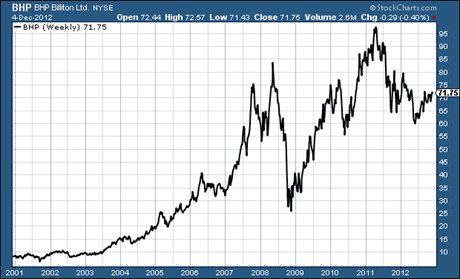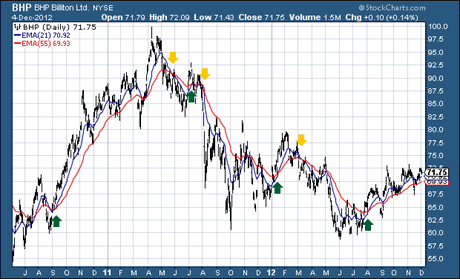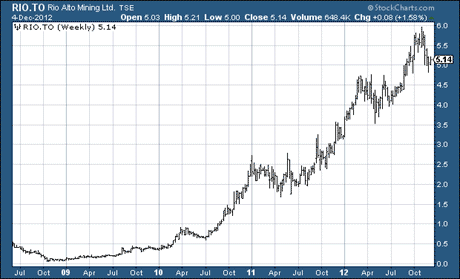I spent some time yesterday and on Tuesday wandering around Mines and Money, London’s biggest mining conference.
The junior mining sector is extremely depressed. Share prices have been badly beaten up, costs are rising, and the outlook for mining’s saviours – China and higher metal prices – is grim.
On top of that, management at junior miners has an unfortunate tendency to do colossally stupid things.
So is there any hope for the sector? I think there just might be – and that’s what I want to look at this morning.
The trouble with junior miners
There was barely a London-listed company at Mines and Money. That says a great deal about the poor quality of Aim (London’s Alternative Investment Market).
It was packed with Australian and Canadian companies who, unable to raise money at home, have made the journey to London hoping they can find it here. (Sorry lads, we haven’t got any money – it’s all gone on houses).
The junior sector is mostly based on exploration and development, rather than production. So it relies heavily on funding. At present, the sector is starved of it. Newsletter writer John Kaiser reckons that of the 1,800 companies he covers, 524 have less than $200,000 in working capital.
The general view was that a third of companies aren’t going to be able to survive this. One depressed chief executive even said that going to the Mines and Money Awards party – usually a great evening – would be like going to a Zombie Ball.
So what’s the problem? It’s a tough environment, yes, but junior miners bring a lot of pain on themselves. One veteran I spoke to declared: “junior mining companies are run by some of the most stupid people I’ve ever met”.
Here’s an example: one company I follow has a market cap of $20m, $2m in cash and a resource of close to two million ounces. Every time the company declares decent drill results, the market takes no notice, because this market doesn’t care about drill results.
So what does the management do? Raise $3m in the middle of the tax-loss-selling season (in other words, the time of year when people are least likely to pay up for mining shares) to do more drilling. They’ve diluted the company by 10% with one fund raising that’ll last just a few months!
It’s plain thick. With management making decisions like this, no wonder the company is so undervalued. No wonder John Kaiser suggests that up to 700 juniors have too much stock out and will be forced to do rollbacks in the coming months.
How mining giants could bail out the juniors
That all sounds pretty miserable. But there’s hope. Let me explain.
BHP Billiton is the world’s largest miner. It operates in 25 different countries. It produces oil, coal, uranium, iron ore, base metals, precious metals, potash, diamonds, natural gas – you name it. I cannot possibly fully understand the geology and the potential of all of BHP’s mines, the political and economic risks in all 25 of the countries it operates in, nor all the factors affecting the price of all the commodities it produces. There will always be something I don’t know. Heck, even CEO Marius Kloppers can’t know everything about the company.
Yet all the collective knowledge and opinions about BHP are condensed into one indicator: its price. All the above issues around the company are interesting, but in a way they’re irrelevant. All we need to know as investors is whether the stock’s going to go up or down. Everything else is noise.
So which way is it heading – what is the trend? A trend could be a minute-by-minute, intra-day pattern or a multi-year phenomenon – it depends on your timeframe.
Over the last 12 years the trend is up. In 2001, BHP was trading at $6. Now it’s $71.
Yet in 2008 it fell from $84 to $21. And at $71 now, it’s still down 30% on its high of almost $100 in spring 2011. Then again, it’s up almost 15% on its lows of $58 earlier this year. But on Monday afternoon, it was trending down.
What is your timeframe?
Here’s the chart of BHP since 2000 – with all that collective knowledge and opinion therein. Ask yourselves which way it’s trending.

(Click on the chart for a larger version)
I have outlined my own trend-following system to you before. It’s not perfect – nothing is – but it suits my timeframe for investments, which is anything from a few months to years.
I use the 21 and 55-day exponential moving averages (EMA). This is the average price over the last 21 and 55 days. Exponential just means that the recent days carry more weight.
For a buy signal, we’re looking for three things: the price is above both averages, both averages are sloping up, and the 21-day EMA crosses up through the 55-day EMA. Vice versa tells you to ‘sell’.
In the chart below, the red line is the 55-day EMA and the blue line the 21-day EMA. I have marked the sell signals in amber and the buy signals in green. I repeat, this is not a perfect system -it doesn’t work well in a whip-sawing market, but it does catch trends.

Most big miners’ charts are saying ‘buy’ right now
The good news for those at Mines and Money who were depressed about mining is that we have a trend in BHP – and it is ‘up’. The world’s largest miner is trending higher. There is a lot of resistance at around $73, yes, but for now we have a buy signal.
What about the wider view? Well, looking at some of the other major, diversified mining companies, I’ve found that most are giving us a ‘buy’ signal. Ones in the ‘buy’ camp include Rio Tinto (just), Xstrata, and Vedanta. Freeport McMoran is on the verge of giving a ‘sell’ signal unless it rallies soon. And Anglo American is a ‘sell’ for now, though it looks as though it might be turning up.
All in all, then, things do not appear to be so bad for senior miners. Those companies on the verge of issuing a sell signal, might well turn up. The winter months tend to be favourable for oil and base metal prices. We’ll see.
Here’s how junior miners can strike it rich
So why is this good news for junior miners? Well, if things are positive at the senior end of the sector, that means acquisitions might be down the road – funding may yet come.
So, Mr Junior Mining CEO, please don’t destroy your company through dilution; don’t ruin shareholders; and don’t use the company to fund your jet-set lifestyles. If you’ve got a decent asset and a decent company structure, you and your shareholders could still do well.
This market is not interested in potential. It doesn’t care about drill results – unless they’re exceptional. It’s interested in cash. Give it what it wants and you – and, more importantly, your shareholders – will be rewarded.
So if you have some near-surface ore that you can truck to a mill, for example – as many of you say you do – then do that.
Here’s one company that chose the production route – Rio Alto mining, whose boss Alex Black I was lucky enough to meet yesterday. It’s gone from 6c to, er, almost $6.

(Click on the chart for a larger version)
Now, Mr Junior Mining CEO, do you get my point?
Full disclosure: I own stock in Rio Alto, but none of the other companies in this piece.
Category: Market updates

